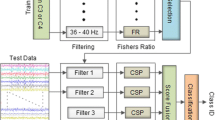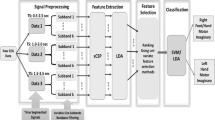Abstract
EEG signals have weak intensity, low signal-to-noise ratio, non-stationary, non-linear, time-frequency-spatial characteristics. Therefore, it is important to extract adaptive and robust features that reflect time, frequency and spatial characteristics. This paper proposes an effective feature extraction method WDPSD (feature extraction from the Weighted Difference of Power Spectral Density in an optimal channel couple) that can reflect time, frequency and spatial characteristics for 2-class motor imagery-based BCI system. In the WDPSD method, firstly, Power Spectral Density (PSD) matrices of EEG signals are calculated in all channels, and an optimal channel couple is selected from all possible channel couples by checking non-stationary and class separability, and then a weight matrix which reflects non-stationary of PSD difference matrix in selected channel couple is calculated; finally, the robust and adaptive features are extracted from the PSD difference matrix weighted by the weight matrix. The proposed method is evaluated from EEG signals of BCI Competition IV Dataset 2a and Dataset 2b. The experimental results show a good classification accuracy in single session, session-to-session, and the different types of 2-class motor imagery for different subjects.








Similar content being viewed by others
References
Mingai L, Yan C, Dongmei H, Jinfu Y (2015) An adaptive feature extraction method in BCI-based rehabilitation. Journal of Intelligent & Fuzzy Systems 28:525–535
Soman S, Jayadeva (2015) High performance EEG signal classification using classifiability and the Twin SVM. Appl Soft Comput 30:305–318. https://doi.org/10.1016/j.asoc.2015.01.018
Yuan Y, Sylvain C, Joe W, Isabelle B (2014) Time-frequency optimization for discrimination between imagination of right and left hand movements based on two bipolar electroencephalography channels Eurasip. J Adv Signal Process 38:1–18
Monalisa Pal, Sanghamitra Bandyopadhyay (2016) Many-objective feature selection for motor imagery EEG signals using differential evolution and support vector machine. 2016 International Conference on Microelectronics, Computing and Communications (MICROCOM)
Salazar-Varas R, Gutiérrez D (2015) An optimized feature selection and classification method for using electroencephalographic coherence in brain–computer interfaces. Biomed Signal Process Control 18:11–18. https://doi.org/10.1016/j.bspc.2014.11.001
Yonghui F, Minyou C, Xufei Z (2015) Extracting features from phase space of EEG signals in brain–computer interfaces. Neurocomputing 151:1477–1485
Avilés-Cruz C, Villegas-Cortez J, Ferreyra-Ramírez A, López AZ (2016) EEG pattern recognition: an efficient improvement combination of ERD/ERS/laterality features to create a self-paced BCI system. Pattern Recognition (MCPR 2016) 9703:231–240
Lotte F, Congedo M, Lécuyer A, Lamarche F, Arnaldi B (2007) A review of classification algorithms for EEG-based brain–computer interfaces. J Neural Eng 4(2):R1–R13. https://doi.org/10.1088/1741-2560/4/2/R01
Philipp Stankevich, Vladimir Spitsyn (2015) A review of brain-computer interface technology. 2015 International Siberian Conference on Control and Communications (SIBCON)
Alotaiby T, Abd El-Samie FE, Alshebeili SA, Ahmad I (2015) A review of channel selection algorithms for EEG signal processing. J Adv Signal Process 66:1–21
Xiaomu S, Suk-Chung Y (2015) Improving brain–computer interface classification using adaptive common spatial patterns. Comput Biol Med 61:150–160
Dalila Trad, Tarik Al-ani, Eric Monacelli and Mohamed Jemni (2011) Nonlinear and nonstationary framework for feature extraction and classification of motor imagery. IEEE Int Conf Rehab Robot 5975488
Huang Manling, Wu Pingdong, Liu Ying, Bi Luzheng and Chen Hongwei (2008) Application and contrast in brain-computer interface between hilbert-huang transform and wavelet transform. 9th International Conference for Young Computer Scientists 1706–10
Wang Lei, Xu Guizhi, Wang Jiang, Yang Shuo and Yan Weili (2008) Application of hilbert-huang transform for the study of motor imagery tasks. IEEE Eng Med Biol Soc Ann Conf 3848–51
Nguyen T, Khosravi A, Creighton D, Nahavandi S (2015) EEG signal classification for BCI applications by wavelets and interval type-2 fuzzy logic systems. Expert Syst Appl 42(9):4370–4380. https://doi.org/10.1016/j.eswa.2015.01.036
Banghua Y, Huarong L, Wang Q, Yunyuan Z (2016) Subject-based feature extraction by using fisher WPD-CSP in brain–computer interfaces. Comput Methods Prog Biomed 129:21–28. https://doi.org/10.1016/j.cmpb.2016.02.020
Liang J, Chaudhuri SR, Shinozuka M (2007) Simulation of nonstationary stochastic processes by spectral representation. J Eng Mech ASCE 133(6):616–627. https://doi.org/10.1061/(ASCE)0733-9399(2007)133:6(616)
Guoqing H, Yanwen S, Ahsan K, Haili L (2016) Time-frequency analysis of nonstationary process based on multivariate empirical mode decomposition. J Eng Mech 142:04015065
Simon R. H. Davies, Christopher J. James (2014) Using empirical mode decomposition with spatio-temporal dynamics to classify single-trial motor imagery in BCI. IEEE Eng Med Biol Soc Ann Conf 4631–4
Zheng J, Liyu H, Jing Z (2012) Energy feature extraction and SVM classification of motor imagery-induced electroencephalograms. J Innov Optical Health Sci 5(02):1250006. https://doi.org/10.1142/S179354581250006X
El-Kafrawy NM, Hegazy D, Tolba MF (2014) Features extraction and classification of EEG signals using empirical mode decomposition and support vector machine. Adv Mach Learn Technol Appl 488:189–198
Trad D, Al-Ani T, Jemni M (2016) Motor imagery signal classification for BCI system using empirical mode decomposition and band power feature extraction. Brain Broad Res Artif Intell Neurosci 7:5–16
Roijendijk L, Gielen S, Farquhar J (2016) Classifying regularized sensor covariance matrices: an alternative to CSP. IEEE Trans Neural Syst Rehabil Eng 24(8):893–900. https://doi.org/10.1109/TNSRE.2015.2477687
Yu Z, Guoxu Z, Jing J, Xingyu W, Andrzej C (2015) Optimizing spatial patterns with sparse filter bands for motor-imagery based brain–computer interface. J Neurosci Methods 255:85–91
Feifei Q, Yuanqing L, Wei W (2015) RSTFC: a novel algorithm for spatio-temporal filtering and classification of single-trial EEG. IEEE Trans Neural Netw Learn Syst 26:3070–3082
Aghaei AS, Mahanta MS, Plataniotis KN (2016) Separable common spatio-spectral patterns for motor imagery BCI systems. IEEE Trans Biomed Eng 63(1):15–29. https://doi.org/10.1109/TBME.2015.2487738
Jianjun M, Lin Y, Xinjun S, Dingguo Z, Xiangyang Z (2015) Simultaneously optimizing spatial spectral features based on mutual information for EEG classification. IEEE Trans Biomed Eng 62:227–240
Wu ShangLin, Wu ChunWei, Nikhil R. Pal, Chen ChihYu, Chen ShiAn and Lin ChinTeng (2013) Common spatial pattern and linear discriminant analysis for motor imagery classification. IEEE Symp Comput Intel Cog Algorithms Mind Brain (CCMB) 146–51
Minyou C, Xuemin T, Li Z (2016) An iterative self-training support vector machine algorithm in brain-computer interfaces. Intell Data Anal 20(1):67–82
Mathworks Help (2017) Continuous and Discrete Wavelet Transforms [Online], available: https://www.mathworks. com/help/wavelet/gs/continuous-and-discrete-wavelet-transforms.html
Wissel T, Pfeiffer T, Frysch R, Knight RT, Chang EF, Hinrichs H, Rieger JW, Rose G (2013) Hidden markov model and support vector machine based decoding of finger movements using electrocorticography. J Neural Eng 10(5):056020. https://doi.org/10.1088/1741-2560/10/5/056020
Clemens Brunner, Robert Leeb and Gernot Muller-Putz (2008) BCI competition IV dataset 2a: 4-class motor imagery. Graz University of Technology [Online], available: http://www.bbci.de/competition/iv/#dataset2a
Robert Leeb, Clemens Brunner and Gernot Muller-Putz (2008) BCI Competition IV Dataset 2b: 2-class motor imagery. Graz University of Technology [Online], available: http://www.bbci.de/competition/iv/#dataset2b
KaiKeng A, ZhengYang C, Chuanchu W, Cuntai G, Haihong Z (2012) Filter bank common spatial pattern algorithm on BCI competition IV Datasets 2a and 2b. Front Nurosci 6:39
Acknowledgements
This work is sponsored by National Natural Science Foundation of China (Grant No.61301012, No.61401117 and No.61471140), the Fundamental Research Funds for the Central Universities (Grant No. HIT.IBRSEM.2013005) and the Sci-tech Innovation Foundation of Harbin (No.2015RAXXJ038).
Author information
Authors and Affiliations
Corresponding author
Rights and permissions
About this article
Cite this article
Kim, C., Sun, J., Liu, D. et al. An effective feature extraction method by power spectral density of EEG signal for 2-class motor imagery-based BCI. Med Biol Eng Comput 56, 1645–1658 (2018). https://doi.org/10.1007/s11517-017-1761-4
Received:
Accepted:
Published:
Issue Date:
DOI: https://doi.org/10.1007/s11517-017-1761-4




